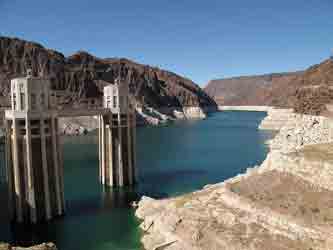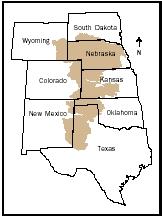 |
The Celestial Wheel
Millennium Contraction Migrations
An In-Depth Forecast July 18, 2010
|
Millennium Contraction Migrations
Digression -- A Millennium Contraction Result
The Celestial Wheel interpretive focus has been on the upcoming late July through August Mars/Saturn conjunction. Remaining is the painstaking process of offering specific predictions for how that will unfold over the coming weeks. The below analysis on migrations during the Millennium Contraction has been in the works for some weeks. It's time to take a Mars/Saturn break and publish it.
The Millennium Contraction is a comprehensive economic, social and cultural transformation. Predictions and results so far have been primarily about the economic losses caused by the real estate bubble bursting and the auto industry's fall -- within the environment the Second Gilded Age's greed and thirst for power. The financial sector's twenty-first century robber barons brought this collapse, just as their late nineteenth predecessors did the same -- then in excessive and risky real estate and railroad lending.
The July 4 In-depth Forecast, Through The Millennium Contraction, is the current exposition on this transformation, adding detail by applying both the U.S. Planetary Cycles and impactive transits -- where the planets are in today's skies. Suggestions for real estate, transportation and investing were also made, but these are naturally very general. How this process actually transforms the American economic and social landscape has not been addressed.
It appears that other long term influences will sculpt this new landscape. These could not be anticipated, at least by this Vedic astrologer. But as mundane (world) astrology cannot be done without knowledge of conditions and trends, those must be included to paint a more accurate and specific predictive picture. These two long term influences are the (gradual) ending of the age of oil and global warming. We've all known about global warming for years and years. The generational shift from fossil fuels to alternative energy production did not become clear until the BP oil spill. Of course, these two influences relate to each other. Alternative energy is needed to ween us off of fossil fuels for their high cost of course, but also for their pollutants adding to global warming.
Yet, it's also true that Vedic Astrology can offer some insight on long term trends, even as specific results may not be seen for some time. As discussed in the May 2004 The Jupiter/Saturn Conjunction -- A New Twenty Year Era, labor globalization comes from 2000 to 2020. It ended with, I've been daydreaming about Vermont in the summer, Sedona in the fall and a Caribbean island in the winter. Migrations are part of this trend. I included that forecast in my decision to relocate. Technological advances are integral to the migration process, which is why I was able to travel across country continuing my business with a Mac laptop and a cell phone. I'm now in North Carolina, and it doesn't matter a whit to readers that I'm not composing this in Arizona. Anyone anywhere can read The Celestial Wheel or e-mail or call for a Vedic consultation. Soon we'll be able to teleconference with similar ease and economy. Note the really important feature in the Iphone 4 is video-phone, a long sought but heretofore unachievable goal.
Major economic and societal shifts are to be expected, for they are in the historical record. The Little Ice Age, from the sixteenth through mid nineteenth centuries, had enormous impacts -- even to such oddities like Stradivarius violins sounds better, cooler temperatures throughout Europe are believed to have caused stunted and slowed tree growth, resulting in unusually dense wood. As to fuel impacts, recall that London, England was blanketed with coal soot for hundreds of years, resulting in fog, injuring health and even changing the color of moths from tan to dark gray. See, London's Historic "Pea-Soupers."
Below is a predictive analysis for major migrations in the U.S. resulting from the combined influences of the Millennium Contraction's economic consequences and those of oil use and global warming. These are naturally speculative, but they are not fanciful. The influences are real, of consequence, and if you are paying attention, the results are already underway. The ship has raised anchor and the harbor. A new voyage has begun. There's no turning back, only advancing now to a new destination.
Today's Celestial Wheel entry describes part of the new journey and its destination -- even as it is incomplete and may not address other, even more fundamental changes. Consider it was the BP oil spill just a few months that stimulated the now wide-spread understanding that there's another energy transformation -- from oil to alternative fuels -- as as humanity has gradually transitioned in a continuing process from wood to coal and then to oil.
Migration Predictions
The U.S. has had many migrations as the nation spread west and responded to changes in technology, demographics and other factors. The most significant recent migration has been from the north to the Sunbelt state Gulf Coast states and the Southwest, ongoing now for forty years or more. Another has been the shift to massive farms in the grain belt.
There is a new migration coming, this one reversing those since the second world war. These migrations will result from the Millennium Contraction's economic factors, ending the age of oil and global warming.
Oil, with its diesel heavy equipment, asphalt highways, tractor trailer trucks and the automobile, opened up the desert Southwest, just as air conditioning made the Gulf Coast livable.
Southwest
The 1936 Hoover dam electrified and irrigated its bordering states -- Utah, Arizona and Southern California. The interstate highway system was part of this, connecting markets and enabling first suburbs and then exurbs.
Thus, the infrastructure was in place for the migration to the Sunbelt states. However, building cities in the desert is not sustainable now -- just as it wasn't for the Native Americans centuries ago. Their abandoned cities dot the region. First, the U.S. did not understand the Colorado River was extremely variable. Second, global warming worsens drought. The Colorado snow pack that feeds the river has been in decline since 1999. Third explosive population growth required more water. Fourth, the drought has increased forest fires. Fifth and sixth, the end of cheap gasoline in 2003, coupled with the Millennium Contractions real estate bust and business decline, has made the modern Southwest city urban sprawl model uneconomical. Worst hit, of course, is Las Vegas, for it grew the fastest, has no secondary water supply and gambling is now viewed as both unaffordable and wasteful.
The Hoover Dam's Lake Meade is pictured here in 2007. The water intake towers are clearly exposed The Glenn Canyon Dam created Lake Powell later in 1963. Today, Lake Meade has dropped to 40% capacity and upriver lake Lake Powell is 57% full. This six-fold combination spells doom for the Southwest. People are already leaving for regions with water, which also naturally have stronger economies -- the Northern Rockies, the Pacific Northwest, the Great Lakes states and the Mid Atlantic to northeast corridor. Agriculture will follow. |
|
Gulf Coast States
The Gulf Coast Sunbelt states have also been hit hard. First, as mentioned above, air conditioning made the South habitable after the Second World War. Oil brought the interstates and cheap gasoline to enable travel and commerce, just like the Southwest. First, textiles left the Northeast for non-union cheaper labor and lower taxes in the South. Other manufacturing followed, creating the rust region in the Midwest, which expanded to the Northeast. Retirees and tourism also fueled growth, especially to Florida.
Global warming brings more intense weather, and the Gulf Coast states have been hammered by hurricanes since Andrew hit Miami in 1992. Freezes have also become more common. Too, like the knowledge failure about the Colorado River's flow variability, no one examined the hurricane cycle, which is similar. During Florida's great growth period beginning in the early seventies, there was also a hurricane cycle lull. Retiree and worker in-migration switched to a net out-migration in 2009. Tourism has fallen off. Flood insurance has skyrocketed in price. Citrus and vegetable farming has been damaged by hurricanes and freezes. The real estate bust hit Florida just as hard as the Southwest. More expensive gasoline has hampered all activities. Now the BP oil spill is both ruining the economies of all the Gulf Coat states and making the densely populated beach areas less habitable.
Like the Southwest, a massive migration is coming. Due to geographical proximity, folks will go north to the Mid Atlantic states. Social and cultural ties will stimulate others to return to the Northeast and Midwest.
Midwest
A final out-migration region is the Midwest.
Again courtesy of the age of oil, mechanized irrigation and farming in the Midwest could soon deplete the Ogallala Aquifer, in which virtually all recharge comes from rainwater and snowmelt. During the last few decades, huge corporate-owned farms have squeezed out family farmers in the Midwest, and their lower prices put family farms in other parts of the country out of business. This image shows that vast 8 state water supply. See also, Time, Water Running Out for America's Biggest Aquifer.
|
|
Expect global warming to continue to increasing tornado destructions, severe periodic flooding storms and also drought.
People will leave these Midwest states for the the north and east -- again where there is adequate rainfall.
History repeats itself. During the 1929 to 1948 Saturn Planetary Cycle in the U.S. chart, the Great Depression's lowered crop prices and drought brought the dust bowl, forcing farmers westward. Ironically, it was the 1936 Hoover Dam that brought water to that irrigated desert, and now that scheme is failing. The dust bowl also stimulated agricultural reforms, including replanting forests decimated across the country. One of Saturn's significations is purification. Agricultural reform will come again, this time in reducing planted acreage, water conservation and other measures. Certainly agriculture will move back to the Great Lakes states and the Eastern Seaboard.
Summary
Migrations can be gradual over decades, or they can empty out an area in a few years if conditions are especially rough due to multiple causes. After all, the greater the number of problems, the few the number of solutions. IT doesn't look good for the Southwest with its plethora of challenges. No one knows yet how badly the oil spill will harm the Gulf Coast. The Midwest could continue for years and years -- but the aquifer there will begin to run dry soon.
I don't know how quickly and dramatically these migration influences will actualize, but it makes sense the forces behind them will have been determinative by the end of the Millennium Contraction in 2015.* Your planning for your own personal transformation, fitting your square pegs into the new round holes, benefits from your awareness of upcoming population shifts.
(*Of course, global warming can continue, for even if greenhouse gases are cut back, the warming effect will continue. Plus, the sunspot cycle impact as well. Still, one hopes humanity will have come to grips with this issue over the next several years. There's always hope!)
Certainly, of course, not everyone will leave Las Vegas, not all the vegetable farmers in the Southwest will fold... But if you're in one of the three affected regions, your plan should be first-based upon whether you will stay and tough it out, or leave. Similarly, if you live in a region that will gain population, your strategy should reflect that coming reality as well.
The March 2004, The Times They Are A Changin, seems like ancient history, but like the May 2004 The Jupiter/Saturn Conjunction -- A New Twenty Year Era, sometimes it takes a while for predictions to be born out.
Copyright
1999-2010 |


